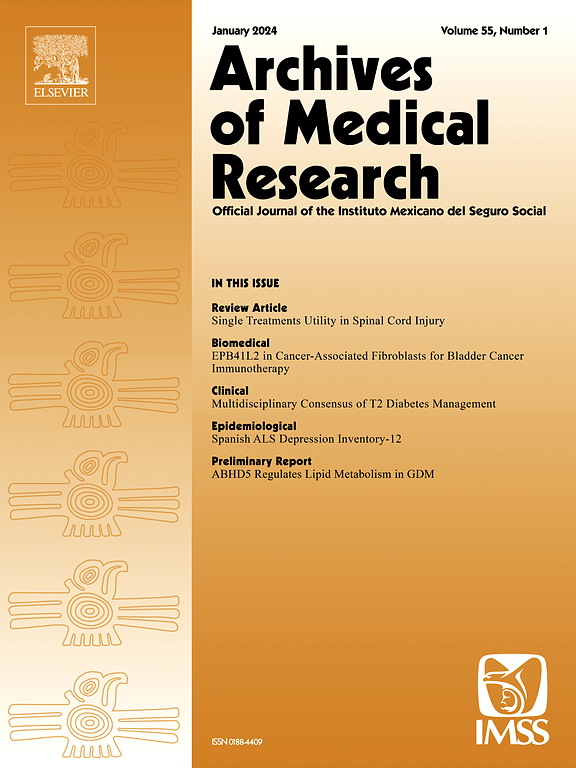墨西哥亨廷顿病患者JPH3基因重复扩增始祖突变的中西部非洲血统
IF 3.4
3区 医学
Q1 MEDICINE, RESEARCH & EXPERIMENTAL
引用次数: 0
摘要
背景JPH3基因的三核苷酸重复扩增会导致亨廷顿病样2(HDL2),在临床上与亨廷顿病无异,被认为是非洲和非洲裔人群特有的疾病。我们在墨西哥太平洋南部的 Costa Chica 地区发现了五个 HDL2 家族。由于墨西哥人口是混血的,因此我们旨在确定扩增的祖先来源,并使用微阵列基因组数据确定突变携带单倍型。方法共纳入 16 个个体(9 个有症状、3 个无症状的突变携带者和 4 个健康的非携带者)。利用全基因组芯片数据估算了全球和本地祖先。主成分和二次判别分析(QDA)被用来推断单倍型的最可能来源,并辅以 SMOTE-Tomek 采样策略。在所有突变基因携带者的同源染色体中,至少有一条染色体的侧翼有一个 1.1 Mb 的区段被推断为非洲人。分阶段基因型分析显示,包含突变的 746 Kb 单倍型中有 412 个 SNPs。这一共享单倍型被一致推断为非洲血统。在78.3%的重采样迭代中,QDA将该单倍型归类为约鲁巴单倍型。结论祖先分析表明,在我们的患者中发现的JPH3重复扩增是一种非洲起源的始祖突变。墨西哥其他导致罕见遗传病的始祖突变表明,拉丁美洲的混血过程是如何导致某些地理区域疾病高发的。本文章由计算机程序翻译,如有差异,请以英文原文为准。
West-Central African Ancestry of the Repeat-Expansion Founder Mutation on the JPH3 Gene in Mexican Patients With Huntington's Disease-Like 2
Background
A trinucleotide repeat expansion of the JPH3 gene causes Huntington disease-like 2 (HDL2), clinically indistinguishable from Huntington's disease and is considered a disease unique to African and Afro-descendant populations. We identified five HDL2 families from the Costa Chica region of southern Pacific Mexico. Because the Mexican population is admixed, we aimed to determine the ancestral origin of the expansion and define the mutation-carrying haplotype using microarray genomic data.
Methods
Sixteen individuals (Nine symptomatic, three asymptomatic mutation carriers and four healthy non-carriers) were included. Global and local ancestry were estimated using whole-genome microarray data. Principal component and quadratic discriminant analysis (QDA) were used to infer the most likely origin of the haplotypes, complemented by the SMOTE-Tomek sampling strategy.
Results
Mean ancestry proportions were 16.26, 27.33, and 56.39% for African, European, and Native American components, respectively. A 1.1 Mb segment inferred as African flanking the JPH3 mutation locus was shared by at least one of the homologous chromosomes of all mutation carriers. Phased genotype analysis revealed a common 746 Kb haplotype containing the mutation that includes 412 SNPs. This shared haplotype was consistently inferred to be of African origin. QDA classified this haplotype as Yoruba in 78.3% of the resampling iterations.
Conclusions
Ancestry analysis suggests that the JPH3 repeat expansion identified in our patients is a founder mutation of African origin. Other founder mutations causing rare genetic diseases in Mexico show how the admixture process in Latin America has contributed to the high prevalence of disease in certain geographical regions.
求助全文
通过发布文献求助,成功后即可免费获取论文全文。
去求助
来源期刊

Archives of Medical Research
医学-医学:研究与实验
CiteScore
12.50
自引率
0.00%
发文量
84
审稿时长
28 days
期刊介绍:
Archives of Medical Research serves as a platform for publishing original peer-reviewed medical research, aiming to bridge gaps created by medical specialization. The journal covers three main categories - biomedical, clinical, and epidemiological contributions, along with review articles and preliminary communications. With an international scope, it presents the study of diseases from diverse perspectives, offering the medical community original investigations ranging from molecular biology to clinical epidemiology in a single publication.
 求助内容:
求助内容: 应助结果提醒方式:
应助结果提醒方式:


